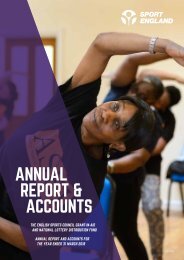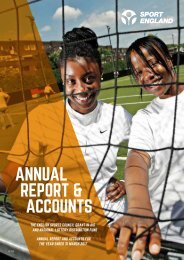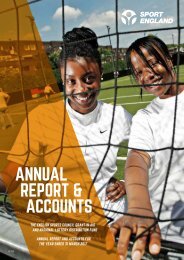sport-england-2016-17-annual-report-and-accounts
You also want an ePaper? Increase the reach of your titles
YUMPU automatically turns print PDFs into web optimized ePapers that Google loves.
Financial asset income is recognised on a receipts<br />
basis due to the timing of statements from the<br />
investment fund. The accounting treatment<br />
adopted materially matches income accrued.<br />
1.5 Grants<br />
Grant awards are recognised as expenditure, <strong>and</strong> if<br />
unpaid, as liabilities if a constructive obligation<br />
exists.<br />
For a constructive obligation to exist the award<br />
commitment must be communicated directly to<br />
the award recipient, <strong>and</strong> Sport Engl<strong>and</strong> has the<br />
authority to commit the expenditure. Grant awards<br />
are only recognised in the year of funding as the<br />
Grant-in-Aid <strong>accounts</strong> cannot guarantee funding<br />
in future years.<br />
Grant awards which are funded from future year’s<br />
funding are shown as contingent liabilities (shown<br />
as future commitments – note <strong>17</strong>).<br />
1.6 Other expenditure<br />
Staff costs are recognised as an expense at the<br />
time that the organisation is obligated to pay<br />
them <strong>and</strong> include the cost of any recorded<br />
untaken leave at the end of the financial year.<br />
Costs relating to the National <strong>sport</strong>s centres,<br />
Sports development <strong>and</strong> Operating costs are<br />
expensed in the year in which they are incurred.<br />
Sport Engl<strong>and</strong> is required to apportion<br />
expenditure between its Exchequer <strong>and</strong> National<br />
Lottery Distribution Fund (Lottery) activities. The<br />
apportionment of expenditure is calculated using<br />
metrics derived from the organisation’s <strong>annual</strong><br />
business planning process, unless the costs are<br />
considered to be entirely Exchequer or Lottery<br />
related. The resulting cost allocations are subject<br />
to <strong>annual</strong> review by the Executive Team. These<br />
calculations are also subject to audit.<br />
The current methodology calculates charges on a<br />
full cost recovery basis in accordance with HM<br />
Treasury’s Managing Public Money. The<br />
expenditure apportioned under this methodology<br />
to Sport Engl<strong>and</strong> Lottery activities are reimbursed<br />
to the Exchequer account (note 9).<br />
1.7 Property operating leases<br />
Payments made under operating leases (rental<br />
agreements) are recognised in the Statement of<br />
comprehensive net expenditure on a straight line<br />
basis over the term of the lease. Lease incentives<br />
(e.g. rent free periods) are recognised as an<br />
integral part of the total lease expense, over the<br />
term of the lease.<br />
1.8 Assets gifted to subsidiaries<br />
Assets gifted to subsidiaries are expensed in the<br />
year in which they are gifted.<br />
1.9 Property, plant <strong>and</strong> equipment<br />
All property, plant <strong>and</strong> equipment, other than IT<br />
Equipment, are owned by The Sports Council Trust<br />
Company (SCTC). Asset additions are funded by a<br />
Lottery grant from the Sport Engl<strong>and</strong> Lottery Fund<br />
<strong>and</strong> capital works paid for by Sport Engl<strong>and</strong><br />
Grant-in-Aid <strong>and</strong> gifted to the SCTC.<br />
L<strong>and</strong> <strong>and</strong> Buildings<br />
Valuations are carried out by external experts.<br />
L<strong>and</strong> is valued <strong>annual</strong>ly. Full valuations of<br />
buildings are carried out on a quinquennial basis,<br />
between full valuations <strong>annual</strong> indexation is<br />
applied. The last full valuation of buildings was<br />
carried out as at 31 March 2014.<br />
Valuations are based on Depreciated Replacement<br />
Cost (DRC) for specialist properties, <strong>and</strong> open<br />
market value for other properties.<br />
The DRC basis generates an open market<br />
valuation of the l<strong>and</strong>. The valuation of each<br />
building is derived through an estimate being<br />
made of the gross current replacement cost of the<br />
buildings <strong>and</strong> other site works, from which<br />
deductions are then made to allow for age,<br />
condition <strong>and</strong> obsolescence.<br />
Any assets under construction are valued at the<br />
costs incurred to date.<br />
Artworks <strong>and</strong> Antiques<br />
The artworks <strong>and</strong> antiques are valued by external<br />
experts. The last valuation was carried out as at 31<br />
March 2014. The valuations are derived with<br />
reference to the retail market (at the valuation<br />
date) <strong>and</strong> the probable cost of replacing the items<br />
when compared with items in a similar condition.<br />
Equipment <strong>and</strong> leasehold improvements<br />
Other property, plant <strong>and</strong> equipment have not<br />
been re-valued as fair value is considered not to<br />
be materially different to depreciated historic cost.<br />
The capitalisation threshold is £1,000 <strong>and</strong> assets<br />
purchased below the capitalisation threshold are<br />
normally expensed in year, with the exception of<br />
grouped assets. Grouped assets are assets, which<br />
individually, are less then £1,000 however together<br />
form a single collective asset.<br />
The English Sports Council Grant-in-Aid Consolidated Accounts for the year ended 31 March 20<strong>17</strong> 67








